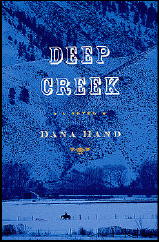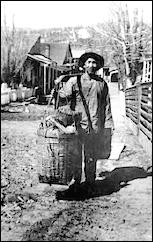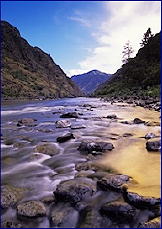Tue 20 Apr 2010
DANA HAND – Deep Creek. Houghton Mifflin Harcourt, hardcover, February 2010. Trade paperback: Mariner Books, March, 2011.

This dark tale of one of the byways of the history of the American Northwest begins with a particularly grim incident. Police Judge Joe Vincent, a one time marshal, is taking his daughter Nell fishing when they snag something big:
Not just one man either. More than thirty bodies are eventually recovered, all Chinese miners. It is June of 1887 in the Idaho territory and Joe Vincent has just been thrown into the case of his lifetime, one that will take him on a personal journey and across countryside and through cities and a sham trial in Oregon before he uncovers the truth.
Deep Creek is based on a forgotten but true incident of Northwestern American history, and Joe Vincent based on Judge Joseph Vincent, the man who investigated the mass murder.
Written in a simple but powerful style by a pair of writers, Will Howarth and Anne Matthews, who have written eighteen books of non-fiction, Deep Creek derives its power from a story of three good, if complex people, drawn into a mystery both deeper and darker than they can imagine.

As Vincent sets out to follow the trail of the bodies up river he is joined by Lee Loi, an ambitious investigator sent by the Sam Yu Company, and Grace Sundown, a half metis mountain guide with secrets of her own. Together they have to piece together how this brutal crime happened and why, while fighting their own demons and the inherent injustice of racial matters at the time.
It might sound as if this is a particularly dark book, but that would be unfair. Above all, the book celebrates the simple goodness of three people who will not allow an injustice to go unmarked or strangers far from their home to go unavenged.
Much of the novel has to do with those three investigators learning to trust each other as they encounter lies, deceit, and cover-ups at all levels and distrust from both those they want to help and those they hope to bring to bear for the crime. At times they face danger from unseen forces, and the violence of the brutal slaughter of the thirty Chinese is never far from the surface.
The novel covers a time period from June of 1887 to August of 1892 but echoes the difficult history of the Asian immigrants to the American West through much of the 19th and the first half of the 20th Century.
The ending of the book is a perfect touch of ironic justice, one that might have come from Jack London at his best. It echoes that and Traven’s Treasure of the Sierra Madre and brings a fine book to a perfect close.

As with real life the novel is not tied up neatly in a package, and justice is not so much served as attempted by three good people and others like them that they meet and ally with. And the writing … the writing is simply beautiful:
This one is something special, with some of the power of works by Ivan Doig and Jim Harrison as well as a compelling mystery and solid detective work by its three protagonists. It goes on a small shelf of powerful novels of the West such as those by Willa Cather, Mari Sandoz, Frederick Manfred, and Wallace Stegner. Once you read it, you won’t forget it.
Note: In 2005 the site where the bodies were found was recognized as a significant American historical place and renamed Chinese Massacre Cove. Final recognition for a forgotten crime.